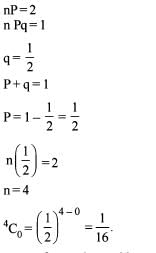Defence Exam > Defence Questions > The mean and the variance in a binomial distr...
Start Learning for Free
The mean and the variance in a binomial distribution are found to be 2 and 1 respectively. The probability P(X= 0) is
- a)1/2
- b)1/4
- c)1/8
- d)1/16
Correct answer is option 'B'. Can you explain this answer?
| FREE This question is part of | Download PDF Attempt this Test |
Verified Answer
The mean and the variance in a binomial distribution are found to be 2...

Most Upvoted Answer
The mean and the variance in a binomial distribution are found to be 2...
Explanation:
Mean and Variance of Binomial Distribution:
- In a binomial distribution, the mean (μ) is given by μ = np, where n is the number of trials and p is the probability of success.
- The variance (σ^2) is given by σ^2 = np(1-p).
Given Information:
- Mean (μ) = 2
- Variance (σ^2) = 1
Relationship between Mean and Variance:
- From the given information, we can write:
2 = np (1)
1 = np(1-p) (2)
Finding p:
- From equation (1), we can write p = 2/n.
- Substituting p = 2/n in equation (2), we get:
1 = 2 - 2/n
n = 2
- Therefore, p = 2/2 = 1.
Finding P(X=0):
- P(X=0) represents the probability of getting 0 successes in n trials.
- Using the formula for binomial probability, P(X=k) = nCk * p^k * (1-p)^(n-k), where nCk is the combination of n items taken k at a time.
- Substituting n=2, p=1, and k=0 in the formula:
P(X=0) = 2C0 * 1^0 * (1-1)^2
P(X=0) = 1 * 1 * 1
P(X=0) = 1
Conclusion:
- Therefore, the probability P(X=0) in this binomial distribution is 1/4, which corresponds to option 'B'.

|
Explore Courses for Defence exam
|

|
Similar Defence Doubts
The mean and the variance in a binomial distribution are found to be 2 and 1 respectively. The probability P(X= 0) isa)1/2b)1/4c)1/8d)1/16Correct answer is option 'B'. Can you explain this answer?
Question Description
The mean and the variance in a binomial distribution are found to be 2 and 1 respectively. The probability P(X= 0) isa)1/2b)1/4c)1/8d)1/16Correct answer is option 'B'. Can you explain this answer? for Defence 2024 is part of Defence preparation. The Question and answers have been prepared according to the Defence exam syllabus. Information about The mean and the variance in a binomial distribution are found to be 2 and 1 respectively. The probability P(X= 0) isa)1/2b)1/4c)1/8d)1/16Correct answer is option 'B'. Can you explain this answer? covers all topics & solutions for Defence 2024 Exam. Find important definitions, questions, meanings, examples, exercises and tests below for The mean and the variance in a binomial distribution are found to be 2 and 1 respectively. The probability P(X= 0) isa)1/2b)1/4c)1/8d)1/16Correct answer is option 'B'. Can you explain this answer?.
The mean and the variance in a binomial distribution are found to be 2 and 1 respectively. The probability P(X= 0) isa)1/2b)1/4c)1/8d)1/16Correct answer is option 'B'. Can you explain this answer? for Defence 2024 is part of Defence preparation. The Question and answers have been prepared according to the Defence exam syllabus. Information about The mean and the variance in a binomial distribution are found to be 2 and 1 respectively. The probability P(X= 0) isa)1/2b)1/4c)1/8d)1/16Correct answer is option 'B'. Can you explain this answer? covers all topics & solutions for Defence 2024 Exam. Find important definitions, questions, meanings, examples, exercises and tests below for The mean and the variance in a binomial distribution are found to be 2 and 1 respectively. The probability P(X= 0) isa)1/2b)1/4c)1/8d)1/16Correct answer is option 'B'. Can you explain this answer?.
Solutions for The mean and the variance in a binomial distribution are found to be 2 and 1 respectively. The probability P(X= 0) isa)1/2b)1/4c)1/8d)1/16Correct answer is option 'B'. Can you explain this answer? in English & in Hindi are available as part of our courses for Defence.
Download more important topics, notes, lectures and mock test series for Defence Exam by signing up for free.
Here you can find the meaning of The mean and the variance in a binomial distribution are found to be 2 and 1 respectively. The probability P(X= 0) isa)1/2b)1/4c)1/8d)1/16Correct answer is option 'B'. Can you explain this answer? defined & explained in the simplest way possible. Besides giving the explanation of
The mean and the variance in a binomial distribution are found to be 2 and 1 respectively. The probability P(X= 0) isa)1/2b)1/4c)1/8d)1/16Correct answer is option 'B'. Can you explain this answer?, a detailed solution for The mean and the variance in a binomial distribution are found to be 2 and 1 respectively. The probability P(X= 0) isa)1/2b)1/4c)1/8d)1/16Correct answer is option 'B'. Can you explain this answer? has been provided alongside types of The mean and the variance in a binomial distribution are found to be 2 and 1 respectively. The probability P(X= 0) isa)1/2b)1/4c)1/8d)1/16Correct answer is option 'B'. Can you explain this answer? theory, EduRev gives you an
ample number of questions to practice The mean and the variance in a binomial distribution are found to be 2 and 1 respectively. The probability P(X= 0) isa)1/2b)1/4c)1/8d)1/16Correct answer is option 'B'. Can you explain this answer? tests, examples and also practice Defence tests.

|
Explore Courses for Defence exam
|

|
Signup for Free!
Signup to see your scores go up within 7 days! Learn & Practice with 1000+ FREE Notes, Videos & Tests.


















